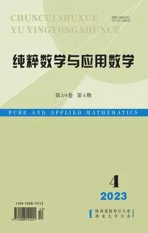Almost primes in generalized Piatetski-Shapiro sequences
2023-02-05YUANShuleiHUANGJingYANXiaofei
YUAN Shulei, HUANG Jing, YAN Xiaofei
(College of Mathematics and Statistics, Shandong Normal University, Jinan 250358, China)
Abstract:Let α ≥1, c ≥1 and β be real numbers, we consider a generalization of Piatetski-Shapiro sequences in the sense of Beatty sequences of the formWe define a natural number to be an R-almost prime if it has at most R prime factors for every R ≥1. It is known that there are infinite R-almost primes in sequences if c ∈(1,cR). The aim of this paper is to improve the up bound of cR by choosing exponent pairs.
Keywords: the Piatetski-Shapiro sequences, exponent pair, almost primes
1 Introduction
The Piatetski-Shapiro sequences are of the form
Piatetski-Shapiro has named such sequences and published the first paper in this problem in reference [1-2]. Forc∈(1,2), it is assumed that there are infinitely Piatetski-Shapiro primes. Piatetski-Shapiro has provedholds for 1 Researchers discussed this issue in different directions. If a natural number has at mostRprime factors, we say it is anR-almost prime. The investigation of almost primes is a material step to the study of primes. In reference [5], Baker, Banks, Guo and Yeager proved there are infinitely many primes of the formp=⎿nc」for any fixedwherenis 8-almost prime. More precisely, In reference [6], Guo proved that holds for any sufficiently largex. Letα≥1 andβbe real numbers, the associated non-homogeneous Beatty sequences are of the form The generalized Piatetski-Shapiro sequences are of the form In fact,it can be understood as the rounding of a twice-differentiable function referring reference [7-10]. Letf(x) be a real, twice-differentiable function such that then {⎿f(n)」:n∈N} is a generalized Piatetski-Shapiro sequence. Obviously, the values of 2-κandcare corresponding. In this paper, we consider the special case off(x)=αxc+β. In reference [11], Qi and Xu proved that there exist infinitely many almost primes in sequencesifc∈(1,cR). In this paper, we improve the up bound ofcRby choosing exponent pairs and give corresponding proof. Our result is as follows. Theorem 1.1For any fixedc∈(1,cR), any realα≥1 and any real numberβ,holds for all sufficiently largex, where the implied constant is absolute. In particular,there have and Compared to the result of Qi, this result improvesc3from 1.1997··· to 1.3411··· andc4from 1.6104··· to 1.6105···. The following notion plays a key role in our debates. We specify it as a form suitable for our applications, it is based on reference [12], which associates level of distribution toR-almost primality. More precisely, we say anN-element set of integersAhas a level of distributionDif for a given multiplicative functionf(d) we obtain As in reference [12], we have the definition and Lemma 2.1LetAbe anN-element set of positive integers, which have a level of distributionDand degreeρ. For some real numberρ Then ProofThis is Proposition 1 of Chapter 5 in reference [12]. Lemma 2.2SupposeM≥1 andλare positive real numbers andHbe a positive integer. Iff:[1,M]→R is a real function, which has three continuous derivatives and satisfies so for the sum we have in which the integerMhsatisfies 1 ≤Mh≤Mfor eachh∈[H+1,2H]. ProofThis is Theorem 1 of reference [13]. Lemma 2.3For anyH≥1 we have with ProofSee reference [14]. We also need the exponent pair theory, which can be found in reference [15] in detail. For an exponent pair (k,l), we define the A-process and B-process: and The proof method mainly comes from Qi and Xu, who adapted the techniques from the original paper of Guo to generalized Piatetski-Shapiro sequences. We shall make some improvements in Sections 3.1-3.3. Define the set AsDis a fixed power ofxand for anyd≥D, we estimate It is clear thatrd∈Aif and only if The cardinality ofAdis the number of integersn≤xcontaining a natural number in the interval((αnc+β-1)d-1,(αnc+β)d-1] with error termO(1). So where By Lemma 2.1 we should prove that for any sufficiently smallε>0 and sufficiently largex. We divide the range ofd, it is sufficient to verify that holds uniformly forD1≤D,N≤x,N1N. Then we need to establish (1) withDas large as possible. Let TakingH=Dxε, by Lemma 2.3 we have where and We splitS1into two parts where and By the exponent pair (k,l), we obtain that We obtain that Now we estimateS2. Whenh=0, the contribution ofS2is Similarly, the contribution ofS2fromh≠0 is Combining (4)-(7), we get Therefore, from (1) we need and Together with (8) and (9), we get By Lemma 2.1,Acontains≫x/logxR-almost primes. We use the weighted sieve with the selection and take By (10) we need so Taking the exponent pair we obtain Similarly, we use the weighted sieve with the selection and take By taking the exponent pair we get In this case, we use Lemma 2.2 to estimate (2). From (4) we get where Letf(n)=Td-1(n+N)cand By Lemma 2.2, we have Hence To ensure (1) is right, we need that We use the weighted sieve with the selection and choose By Lemma 2.1 and (12) we require hence These complete the proof of Theorem 1.1.2 Preliminary lemmas
3 Proof of Theorem 1.1
3.1 Estimation for R=3
3.2 Estimation for R=4
3.3 Estimation for R=5
